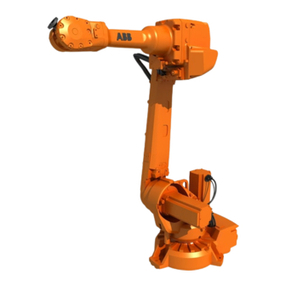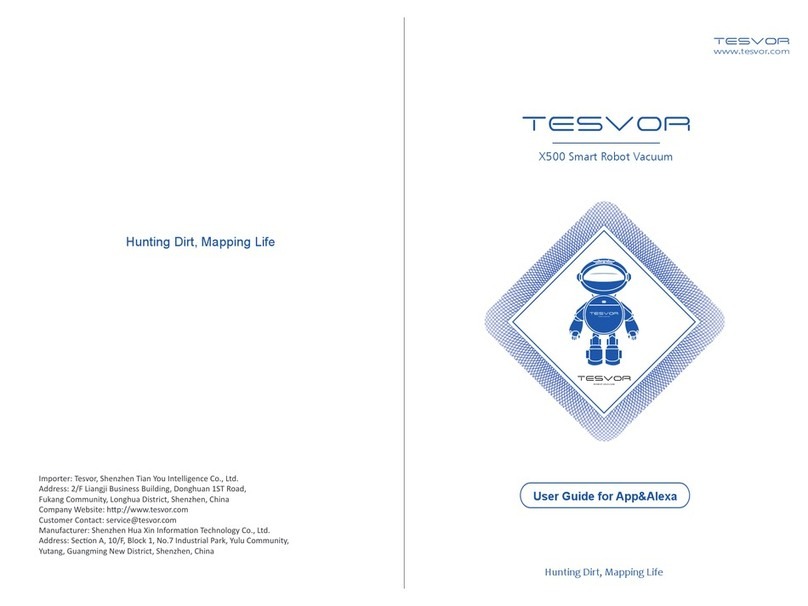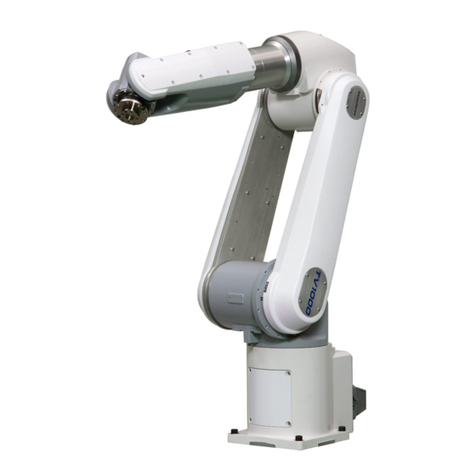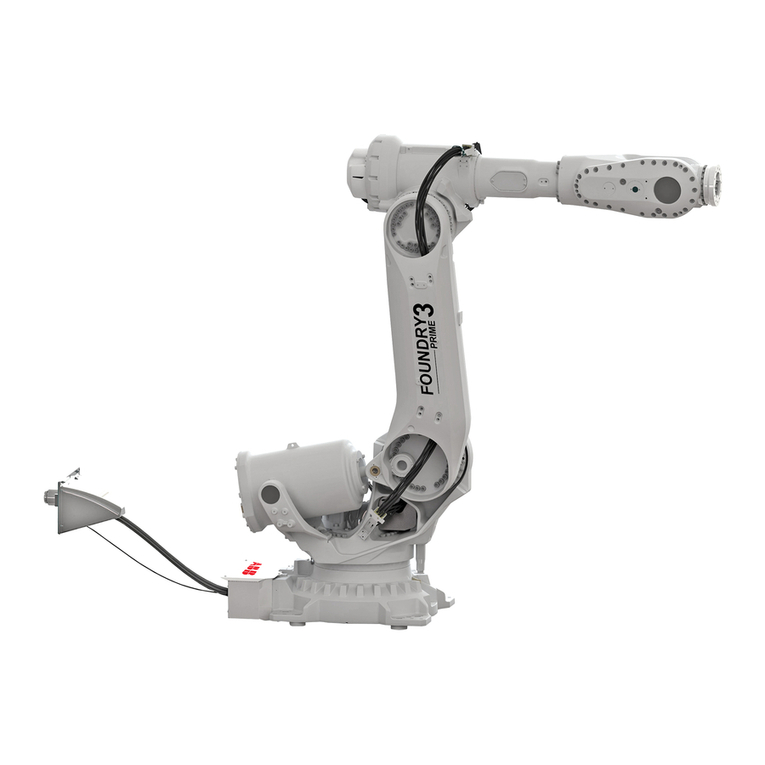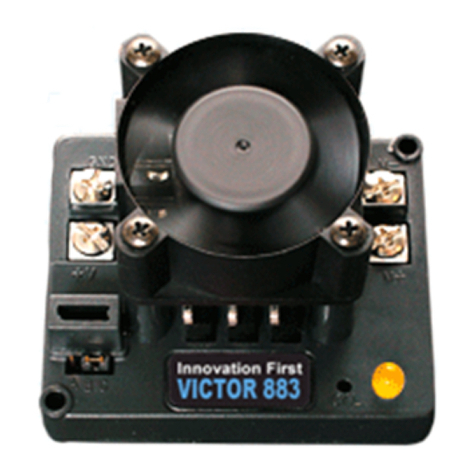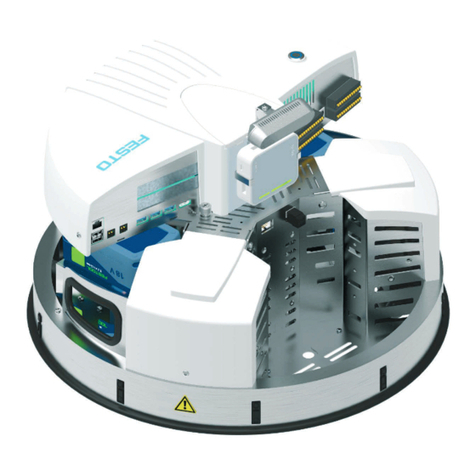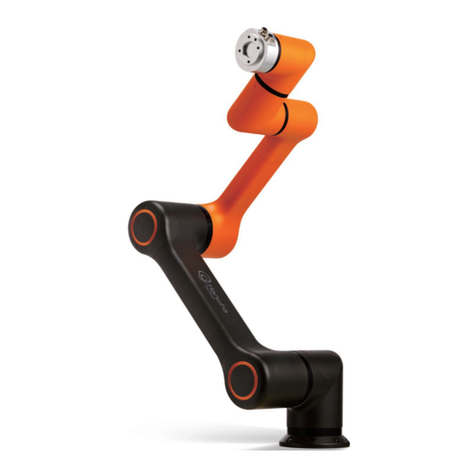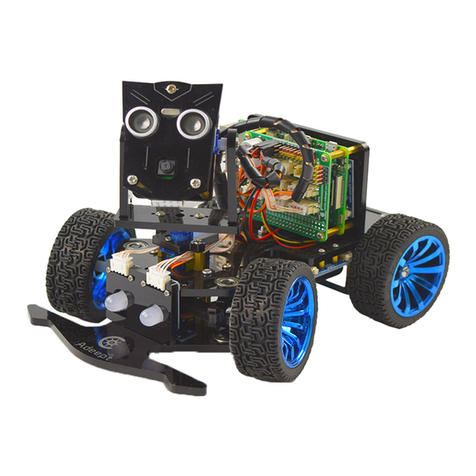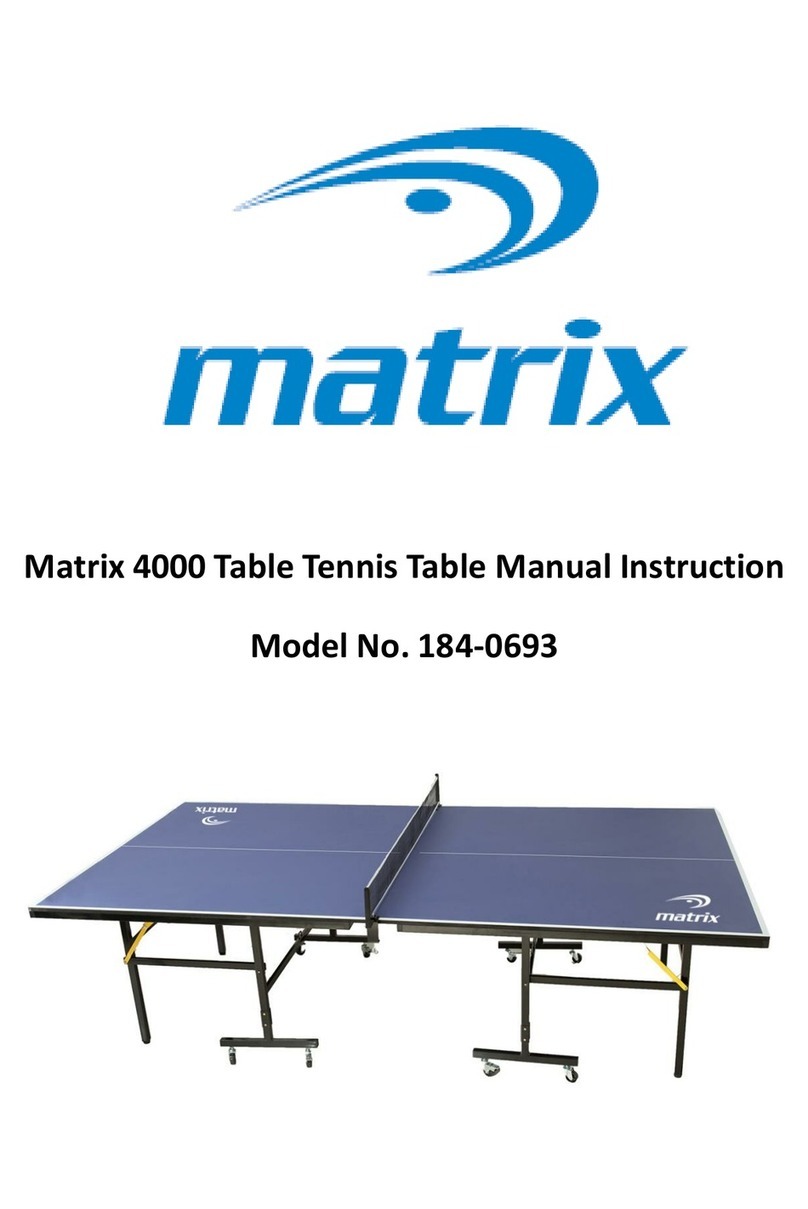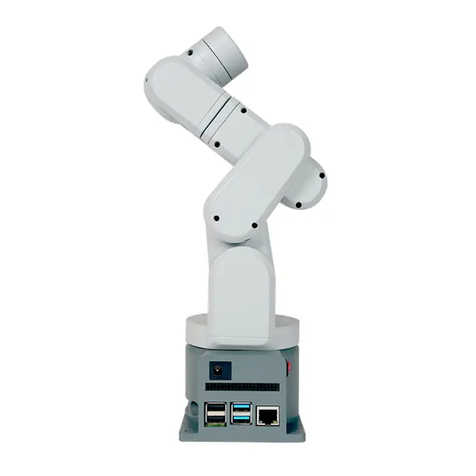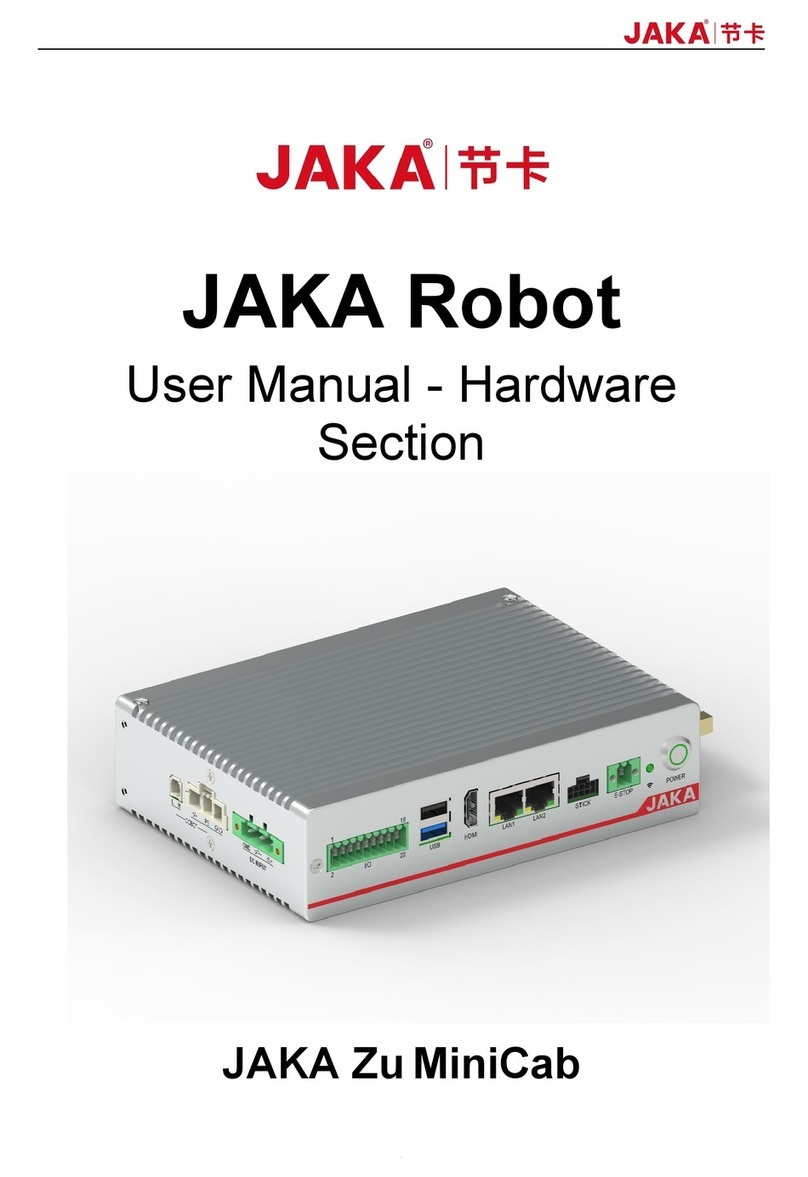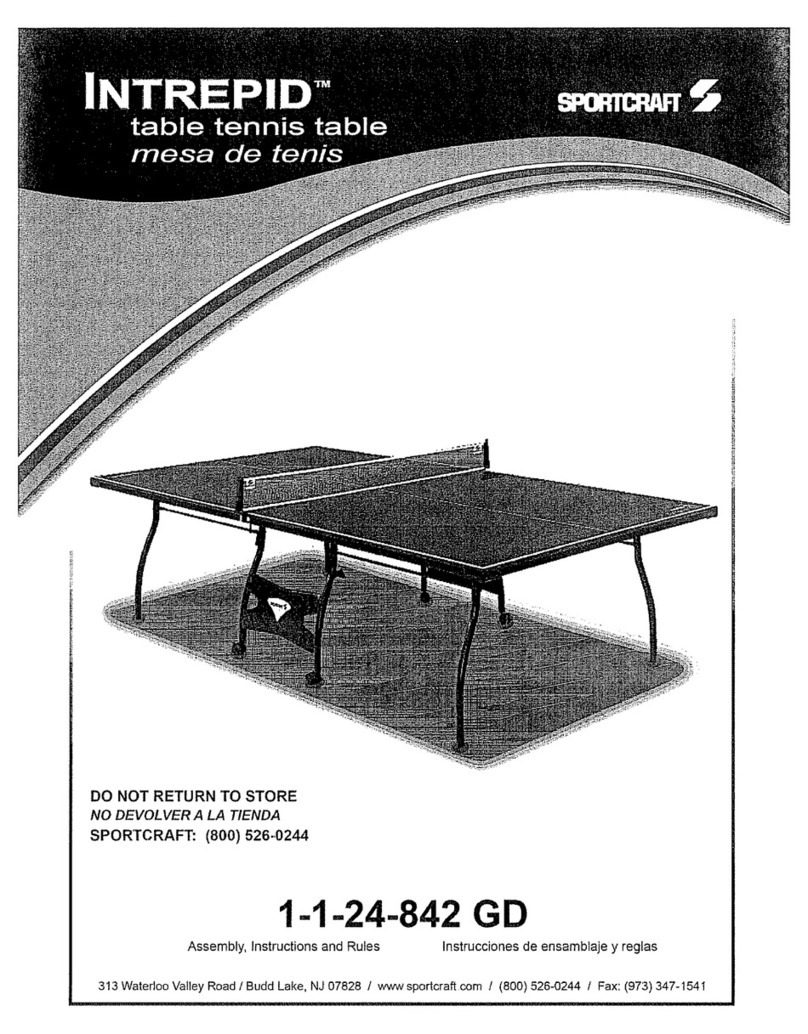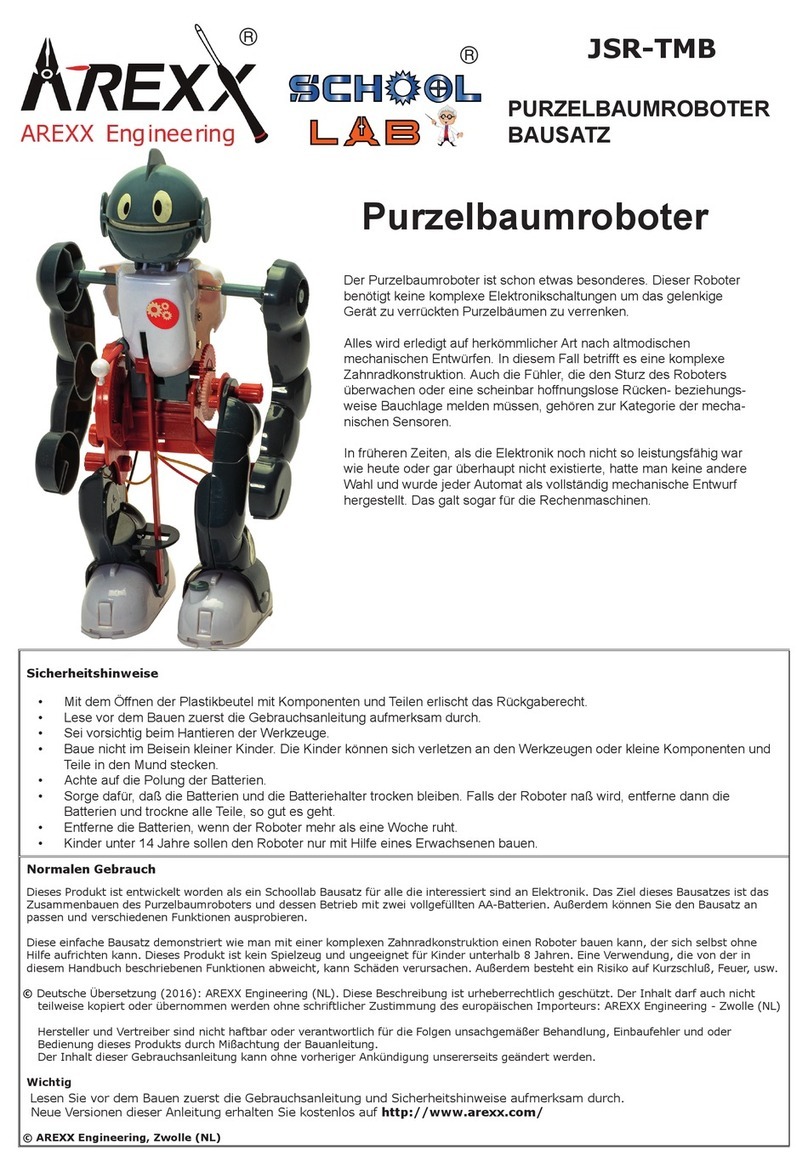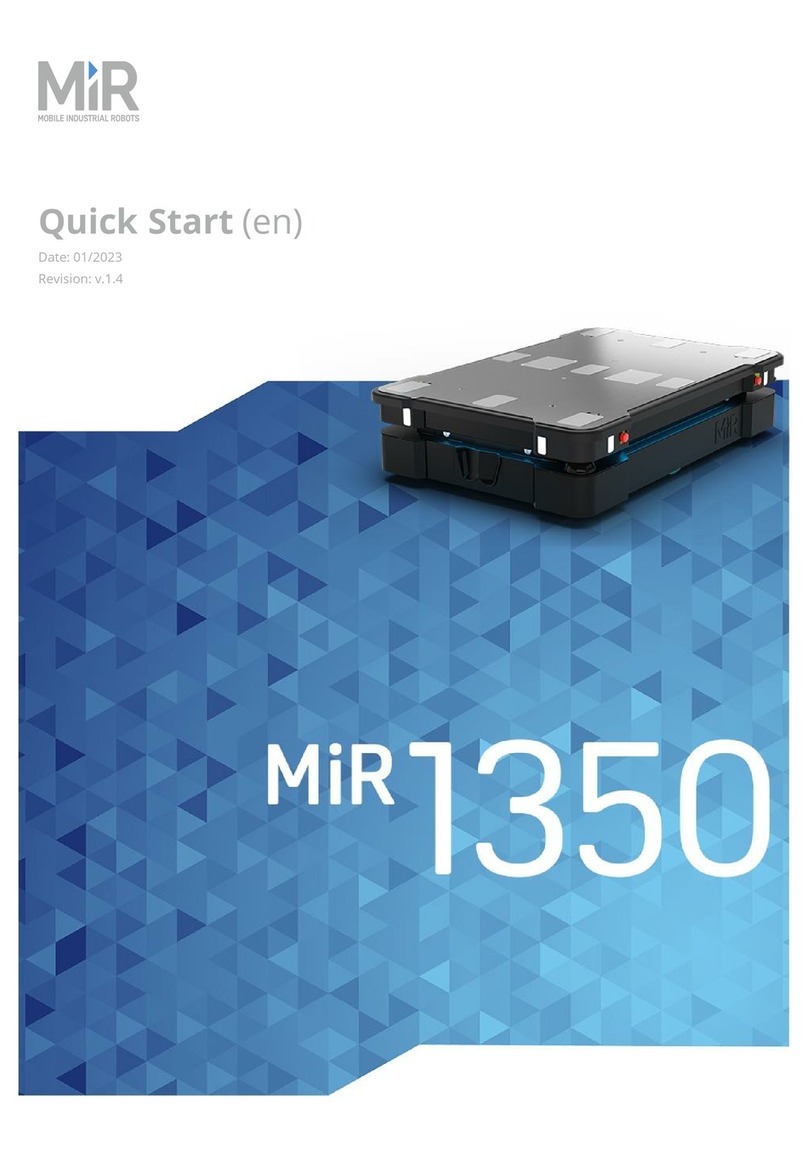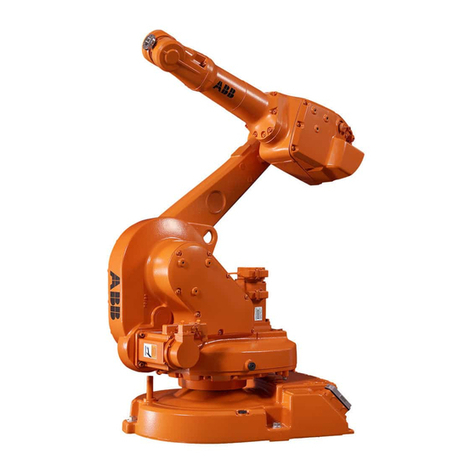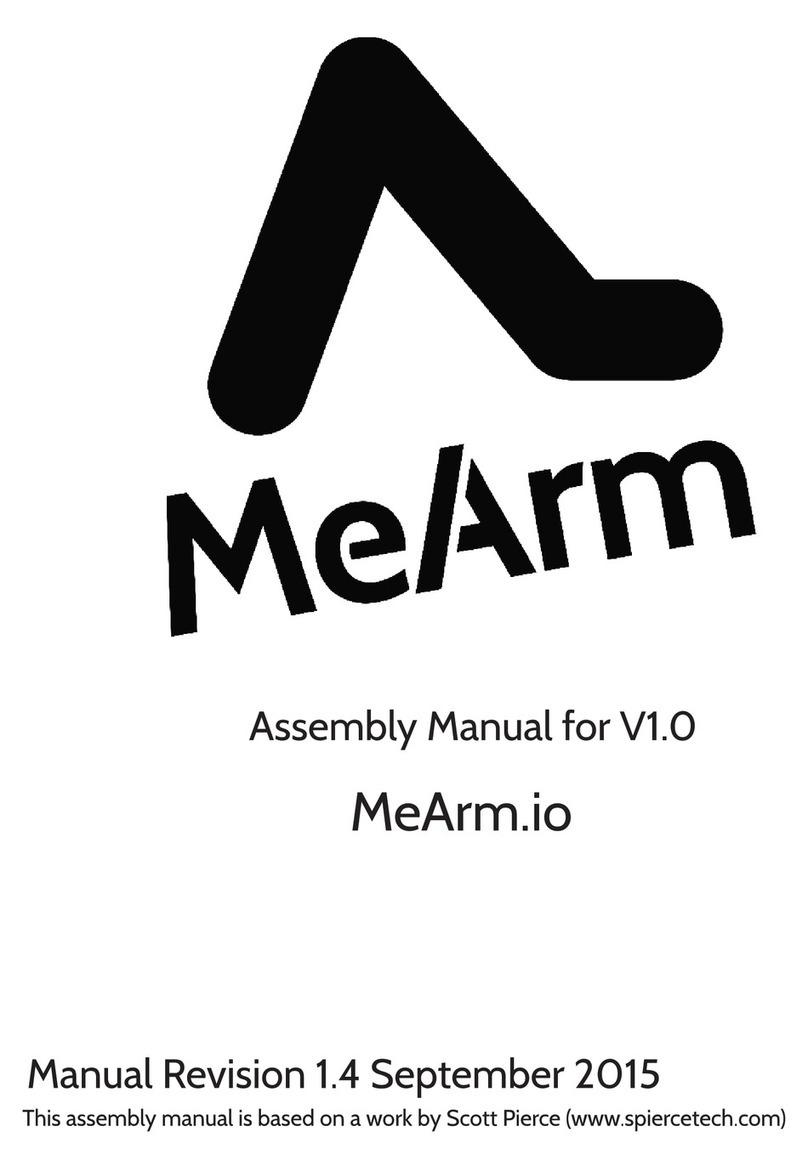Delta DRV70L Series User manual

Delta Articulated Robot
DCV Controller
User Manual

1
Preface
Thank you for using this product. This manual contains information related to the Delta Articulated
Robot series and provides instructions that you must follow to safely operate the robot. Before
operating the robot, read this manual carefully to ensure your safety and proper robot use. In addition,
keep this manual in a safe location for reference whenever required.
This manual applies to the DRV70L and DRV90L Series robots and the DCV Series robot controller.
The DRV70L and DRV90L Series robots work only with our company’s DCV Series controller. Do not
modify the robot and DCV controller or use it with other robots and controllers. Our company will not be
held responsible for any injuries or fatalities caused by accidents that result from doing so.
The following are the robot models and document numbers and versions for this manual.
Published By: Delta Electronics Inc.
Applicable Robots: DRV70L Series and DRV90L Series
Version: V1.0
The contents of this articulated robot manual include:
Precautions for safe controller use
Transportation and Installation
Controller installation and inspection
Safety protection
Wiring
Maintenance
Troubleshooting
Due to the varied working environments and operator safety, we provide special training for personnel
who work with articulated robots. Contact your local dealer or Delta for related training courses. This
manual is a reference for the following users:
System integration designer
Installation and wiring workers
Maintenance and inspection workers

2
Caution
Read this manual carefully before operating the robot to ensure proper use. In addition, keep this manual
in a safe location for reference whenever required.
You will learn do to the following tasks when you have finished reading this manual:
Set up the robot in a safe and protected location with safety protection such as railings and gratings.
Do not operate the robot outside the safety protection area to prevent injuries to the operator.
The installation environment must have no steam, corrosive gas or flammable gas to prevent
accidents such as malfunctions or explosions.
Read this manual carefully before wiring the DCV controller and the robot to prevent damage to the
robot and the DCV controller.
The equipment must be grounded properly.
Do not disassemble or change the wiring while the power is on to prevent electrical shocks.
Ensure that the emergency stop device can be operated at any time before powering the robot on.
Turn off the power to the DCV controller before performing repairs or maintenance.
Do not get close to the operating range of the robot before and after powering on for operations, and
leave a warning in an obvious place to prevent injuries or fatalities to the workers.
If you have questions concerning the robot use, please contact your dealer or our company’s Customer
Service Center.
The copyright of this manual belongs to Delta Electronics Inc. This manual cannot be copied or
duplicated in whole or part without written approval from our company. Its contents must not be passed
on to a third party, nor can it be used for any unauthorized purposes. Any violations will result in a
lawsuit.
The contents and specifications in this manual may change without further notification. You can
download the latest version from the Delta website.

3
Safety Notice
This manual includes safety precautions for user safety and to prevent damage to the robot. Warnings
and notes in this manual describe important safety precautions. Warnings describe supplementary
explanations. Users must read the items in the warning, danger and prohibited notes carefully to
prevent accidents or injuries to the workers.
Only qualified workers should install and transport the robot and they should comply with the regional,
country and local laws and regulation requirements.
The final system integrator should integrate the robot and the robot’s peripherals as well as execute the
construction of the safety protection devices to ensure the overall system safety.
This robot is designed only as an accessory for specific applications. We strongly suggest that you do
not modify this robot or use it for any application processes other than what it is designed for. If you
have any application problems, do not use the robot until you have received detailed explanations from
your dealer.
Definition of Robot Operators
Operator:
Able to perform operations such as powering the DCV controller ON/OFF.
Able to start the robot from the final system integrated operating panel.
Program Editor:
Performs operations with the robot.
Uses the manual mode to operate the robot or for teaching from outside the safety railings.
Repair or Inspection Worker:
Performs simple operations on the robot.
Uses manual mode to operate the robot from outside the safety railings.
Performs operations such as maintenance, repairs, adjustments and replacements to the robot and
DCV controller.
Note: Read this manual carefully before operating, maintaining or inspecting the robot and DCV
controller, and be sure to follow the safety regulations. Please contact our company for details if you
have any questions.

4
Definitions of Prohibited, Danger and Warning
For your safety, read this manual before using the robot and have a clear understanding of all contents
related to safety and warnings.
The following table explains the symbols “Danger”, “Warning”,
“Prohibited” and “Noise Prevention”.
“Danger”
There is imminent danger of fatalities or severe injuries to the workers if not
prevented.
“Warning”
There is a potential danger of fatalities or severe injuries to the workers if not
prevented.
“Prohibited”
These activities are absolutely prohibited. Failure to comply may result in damage
or malfunctions in the product causing the product to be unusable or it may result
in injuries to the workers.
Noise Prevention
There is excessive noise that may affect the operator’s hearing when the robot is
operating. Operators should wear ear protection to protect their hearing.

5
Installation Safety
Read this manual carefully before installing the robot to make sure that you install
the robot in a suitable location and environment to avoid affecting the mechanisms
and useful life of the electronic components, or encounter other safety problems.
The DRV70L and DRV90L Series robots can work only with our company’s DCV
Series controller. Do not modify the machine and wiring or use it with other
controllers. Our company will not be held responsible for any injuries or fatalities
caused by accidents that result from doing so.
Follow the instructions in this manual to correctly transport and install the robot and
DCV controller to prevent damage to the robot or DCV controller.
Related licenses are required for workers who operate equipment such as stackers
or forklifts.
Workers must wear proper safety work clothes, helmets, gloves and shoes when
installing the robot to ensure their safety.
On automated production lines, the operating range of multiple robots may overlap.
Make sure that they do not interfere with one another to prevent damage to the
robots from impacts.
Please do not add additional equipment such as cables or hoses inside the
mechanism. When installing the robot’s exterior cables, ensure that the cables and
mechanisms do not interfere with one another during operations.
Use only clean dry air (CDA) for the air source at the robot air hose input terminal.
You can use the robot in IP40 environments and it is able to resist solid matter with
a diameter over 1mm. It is not protected against any liquids.
Follow the manual and install the safety protection devices such as railings,
gratings, regional lasers or pressure pads to prevent injuries or other dangers to the
workers from impact with the robot in its operating range.
Install the user operating buttons and alarm indicators outside the railings to ensure
safe use. The operating interface should be at a suitable height (0.6–1.7 m) for
operators to reach easily.
Do not turn the power on and off frequently to prevent damage to the DCV
controller.
Install the robot system under the specified conditions; in the foreseeable use
period, the robot may not be tilted or moved by uncontrolled methods during
transportation, assembly, disassembly, suspended or discarded periods.
Properly ground all robot systems before connecting the power.
The final system integrator should install protection devices to prevent users from
getting close to the danger area.
Removing or changing the locations of any safety warning labels on the equipment
is strictly prohibited to prevent danger and injuries to the workers.
Performing any unsafe actions at the safety warning locations on the equipment is
strictly prohibited to prevent injuries to the staff.
Workers must not stand underneath when using equipment such as stackers or
forklifts to move the robot to prevent injuries or other dangers.
Placing objects on top of the robot, DCV controller or cables is strictly prohibited to
prevent damage to the robot, DCV controller or cables.
Changing or modifying the robot and DCV controller is strictly prohibited to prevent
damage to the robot or DCV controller and danger to the workers. Our company will
not be held responsible for any work accidents.
Installation and wiring the robot by unqualified people without the related
professional knowledge or licenses is strictly prohibited.

6
Use and Operation Safety
Read this manual carefully before using the robot to ensure proper use and the
workers safety.
Due to varied operational environments and operator safety considerations, our
company provides dedicated training for personnel who work with the robot to
ensure safe use. Please contact our company or your local dealer if training is
needed.
Wire the robot according to this manual. The wiring must be performed by
qualified workers with related professional knowledge or licenses.
The DRV70L and DRV90L Series robots can work only with our company’s
DCV Series controller. Do not modify the machine and wiring on or use it with
other controllers. Our company will not be held responsible for any injuries or
fatalities caused by accidents that result from doing so.
Use our company’s handheld teaching pendant and install it on the DCV-2J00-
AA controller to perform manual operations and to edit programs.
Do not use this robot on production lines where there are flammable, explosive,
or toxic conditions or there is the risk of the robot being sprayed by liquids.
Select a suitable model according to the load capability. Do not exceed the
machine model specifications.
The robot is a partially completed machine. The assembly and construction of
the protection and safety circuits are the responsibility of the final system
integrator.
Keep all children and visitors a safe distance away from the robot’s operating
area.
Do not wear loose clothes, ties, rings or bracelets, and wear protective nets as
these things can get caught easily in the machine by accident and cause
injuries to the workers or other dangers during operations.
Turn off the power, isolate the power properly and wait for the robot to stop
completely when the robot is no longer in use before leaving the area.
Install safety protection devices such as railings, gratings, laser scanners or
pressure pads according to the instructions in the manual to prevent workers
from entering the working range of the robot and being injured by the robot.
Confirm that there is no one inside the railings before operating the robot.
Do not interact with other workers while operating the robot. A lack of attention
may result in a collision with the robot or injuries to other workers.
Install the user operating buttons and alarm indicators outside the railings to
ensure safe use. The operating interface should be at a suitable height (0.6–1.7
m) for operators to easily reach.
Use the key selection switch to change between modes. The keys must be able
to be removed in any mode.
The senior supervisor should keep the mode selection switch key. Do not drop it
carelessly or leave it inserted in the selection switch to prevent other workers
from accidentally activating the robot, and causing injuries to the workers.
Do not stand in the range of the robot when teaching the robot manually for the
first time to prevent danger from being unfamiliar with the operations.
Use slow speed operations when operating the robot manually for the first time;
otherwise unfamiliarity with the operations may result in damage to the robot
from impact or causing injuries to other workers.
Do not turn the power on and off frequently to prevent damage to the DCV
controller.

7
Improper operations may damage the robot.
When a collision occurs involving the robot, first turn off the power to the robot
and then check the robot’s components and cables to make sure that they are
not damaged before turning the power back on and performing operations
again.
Use a safety lock on the railing switch when entering the railings to operate the
robot to prevent the railings from closing suddenly, causing the robot to be
activated accidentally.
Turn off the power before removing the teaching pendant cable from the DCV
controller to prevent damage to the teaching pendant.
The location of the interlock switch between the structure of the safety
protection device and the protection device should comply with EN ISO 14120
and EN ISO 14119 standards, and the safety distance should be designed
according to EN ISO 13857 standards.
Do not make any changes to any components on our company’s handheld
teaching pendant, including the Emergency Stop and Enable switches. Doing so
lowers the safety performance and level, or may even eliminate the safety
protection.
Short-circuiting any safety protection signals on the DCV controller is strictly
prohibited, and our company will not be held responsible for any work accidents
that may occur.
When operating the robot, all workers are prohibited from standing close to or in
the robot working range to prevent injuries to the workers.
Do not unplug any cables on the DCV controller while the robot is operating to
prevent damage to the DCV controller.
Do not open the protective cover or protection device while the machine and
robot are operating.
Maintenance Safety
Properly perform maintenance and inspection according to the manual to prolong
the useful life of the robot.
Add a safety lock on the power switch on the controller when performing
maintenance or repair operations to the robot, and place a “Do not power on” safety
warning in an obvious place.
Replacing damaged internal DCV controller components with other brands of
components is prohibited to prevent danger or decrease the safety performance
levels.
Make sure foreign objects do not get attached to, or enter the robot when
performing maintenance or inspection.
Use only oil that meets the specifications during maintenance to prevent damaging
the performance of the robot or the mechanical components.
Protection devices and repair doors in the danger areas that need to be opened or
removed regularly for the purpose of operations, maintenance, cleaning or
configuration should be interlocking.
Workers performing maintenance or repairs to the robot or robot system should
receive the necessary process training to execute the tasks required. Use only
genuine parts to prevent grave dangers to the workers.
The processing of waste material should comply with local laws and regulations,
and should be treated carefully.

8
Any changes to the maintenance schedule of the robot and maintenance oil are
strictly prohibited.
Maintenance and inspection of the DCV controller and robot is prohibited while
power is on to prevent electrical shock or injuries to the workers.
When a robot component is damaged, replacing it with other brands of components
is prohibited to prevent damaging the performance of the robot or the components.
Wait 10 minutes before opening the controller box after powering it off because
there is residual voltage in the controller that may cause electrical shocks.

9
Contents DRV70L/90L Series Manual
Caution ............................................................................................2
Table of Contents ...........................................................................9
1. Warning Label Explanations ...................................................14
1.1 Warning Label Explanations.................................................................................16
1.2 Product Label Explanations..................................................................................17
2. Controller Specifications .........................................................19
2.1 Controller Specifications.......................................................................................21
3. Transport and Installation........................................................23
3.1 Transportation ......................................................................................................24
3.1.1 Transport of the Robot and Controller Together.......................................24
3.1.2 Transporting the Controller Alone.............................................................25
3.2 Installation ............................................................................................................26
4. Robot Safety Protection...........................................................28
4.1 Robot Safety Protection .......................................................................................29
4.2 Robot Safety Protection Construction and Installation .........................................30
4.2.1 Emergency Stop Device Installation.........................................................30
4.2.2 Emergency Pull-rope Device Installation..................................................31
4.2.3 Railings Installation ..................................................................................32
4.2.4 Safety Gratings Installation.......................................................................34
4.2.5 Safety Mat Installation ..............................................................................35
4.2.6 Laser Scanner Installation ........................................................................36

10
5. Wiring.........................................................................................37
5.1 Construction of the Controller Peripheral System.................................................39
5.2 Controller Interface Description ............................................................................40
5.2.1 Power Input ..............................................................................................40
5.2.2 RS-232/485 Wiring ...................................................................................42
5.2.3 Ethernet Connector ..................................................................................43
5.2.4 DMCNET Connector ................................................................................43
5.2.5 Handheld Teaching Pendant Connector...................................................46
5.2.6 Safety Connector......................................................................................48
5.2.7 System. DI/O ............................................................................................51
5.2.8 User. DI/O ................................................................................................58
5.2.9 External Encoder......................................................................................63
5.2.10 Robot Connector ......................................................................................64
6. Connecting with the Robot ......................................................65
6.1 Robot Signal Connector .......................................................................................67
6.2 Wiring of the Robot’s Built-in Solenoid Valve .......................................................68
7. Quick Wiring..............................................................................72
8. Maintenance ..............................................................................77
8.1 Fan Filter Cleaning ...............................................................................................78
9. Accessories...............................................................................79
9.1 Controller Accessory Pack ...................................................................................81
9.2 Optional Controller Peripheral Accessories..........................................................82
9.2.1 EMI Peripheral Accessories .....................................................................82
9.2.2 Extension Cord Accessories.....................................................................83
9.2.3 DI/O Expansion, Driver Accessories ........................................................83
9.2.4 Handheld Teaching Pendant ....................................................................87
9.2.5 Robot Cable .............................................................................................87

11
List of Figures
Figure 1.1 Sticker Locations on the Front of the Controller................................................................... 16
Figure 1.2 Sticker Location Behind the Controller................................................................................. 16
Figure 1.3 Product Label Location......................................................................................................... 17
Figure 1.4 Product Label Location......................................................................................................... 17
Figure 2.1 Controller Appearance and Dimensions .............................................................................. 22
Figure 3.1 Fork Lift and Lift Icons .......................................................................................................... 24
Figure 3.2 Fork Lift Transportation Illustration....................................................................................... 25
Figure 3.3 Controller Installation Space ................................................................................................ 27
Figure 4.1 Emergency Stop Button ....................................................................................................... 30
Figure 4.2 Emergency Stop Switch Reset Method................................................................................ 30
Figure 4.3 Emergency Stop Safety Disconnect Symbol ....................................................................... 30
Figure 4.4 Safety Pull-rope Switch Construction Example.................................................................... 31
Figure 4.5 Robot Installation and Railing Protection Installation Height ............................................... 32
Figure 4.6 Wrong Railings Installation Height ....................................................................................... 33
Figure 4.7 DRV70L Safety Grating Installation Distance ...................................................................... 34
Figure 4.8 DRV70/90L Safety Mat Laying Range ................................................................................. 35
Figure 4.9 Laser Scanner Installation Illustration .................................................................................. 36
Figure 5.1 Controller Peripheral System Composition .......................................................................... 39
Figure 5.2 Power Input Terminal Location............................................................................................. 40
Figure 5.3 Power Terminal Wiring ......................................................................................................... 40
Figure 5.4 Controller with EMI Filter and Electric Reactor .................................................................... 41
Figure 5.5 RS-232/485 Connector Location.......................................................................................... 42
Figure 5.6 Ethernet Connector Adapter Figure ..................................................................................... 43
Figure 5.7 DMCNET Connector Location.............................................................................................. 43
Figure 5.8 DMCNET Connection Figure................................................................................................ 44
Figure 5.9 Controller with External Driver System Architecture Connected ......................................... 45
Figure 5.10 ASD-DMC-RM32MN .......................................................................................................... 45
Figure 5.11 ASD-DMC-RM32NT ........................................................................................................... 46
Figure 5.12 Handheld Teaching Pendant Connection Figure............................................................... 46
Figure 5.13 Handheld Teaching Pendant Enabling Switch Figure ....................................................... 47
Figure 5.14 Handheld Teaching Pendant Bypass Connector Location ................................................ 47
Figure 5.15 Safety Connector Location ................................................................................................. 48
Figure 5.16 Wiring Example of a Single Emergency Stop Button......................................................... 49
Figure 5.17 Wrong Wiring of a Single NC Emergency Stop ................................................................. 49
Figure 5.18 Wrong Wiring of a Single NC Emergency Stop with Safety Signal Connected................. 49
Figure 5.19 Wiring Example of Multiple Emergency Stop Buttons ....................................................... 50
Figure 5.20 Wiring Figure of Multiple Safety Protection Devices.......................................................... 50
Figure 5.21 Safety Door Switch Figure.................................................................................................. 50
Figure 5.22 Electromagnetic Safety Switch Wiring ............................................................................... 51
Figure 5.23 System .DIO and DC Output Connector Locations ........................................................... 52
Figure 5.24 Input Signal DI Wiring......................................................................................................... 52
Figure 5.25 System DO Controller Voltage Output NPN Wiring ........................................................... 53
Figure 5.26 System DO Controller Voltage Output NPN Wiring ........................................................... 53
Figure 5.27 System DO Controller Voltage Mixed Output Wiring ......................................................... 53
Figure 5.28 System DO Upper Controller Voltage Output NPN Wiring ................................................ 54
Figure 5.29 System DO Upper Controller Voltage Output PNP Wiring ................................................ 54
Figure 5.30 System DO Upper Controller Voltage Mixed Output Wiring .............................................. 54
Figure 5.31 User .DIO Jack Locations................................................................................................... 59
Figure 5.32 NPN Wiring for When the Input Signal DI Uses the Power of the Controller Itself............ 59
Figure 5.33 PNP Wiring for When the Input Signal DI Uses the Power of the Controller Itself............ 59

12
Figure 5.34 Input Signal DI Connected to the Upper Controller Using NPN Connection ..................... 60
Figure 5.35 Input Signal DI Connected to the Upper Controller Using PNP Connection ..................... 60
Figure 5.36 User DO Controller Voltage Output NPN Wiring................................................................ 60
Figure 5.37 PNP Wiring for When the Input Signal DI Uses the Power of the Controller Itself............ 61
Figure 5.38 User DO Controller Voltage Mixed Output Wiring.............................................................. 61
Figure 5.39 User DO Upper Controller Voltage Output NPN Wiring..................................................... 61
Figure 5.40 User DO Upper Controller Voltage Output PNP Wiring..................................................... 62
Figure 5.41 User DO Upper Controller Voltage Mixed Output Wiring................................................... 62
Figure 5.42 External Encoder Connector Location ............................................................................... 63
Figure 5.43 Robot Connector Connection Location .............................................................................. 64
Figure 5.44 Robot Cable........................................................................................................................ 64
Figure 6.1 Internal Wiring of the Robot 12Pos Signal Connector ......................................................... 67
Figure 6.2 Location of Solenoid Valve Inside the Robot ....................................................................... 68
Figure 6.3 Wiring Diagram of the Robot’s Built-in Solenoid Valve........................................................ 68
Figure 6.4 Internal Wiring of the Robot’s 12Pos Signal Connector....................................................... 69
Figure 6.5 TCP Terminal Air Pipe and Sensor Wiring Example............................................................ 70
Figure 6.6 Robot Clasping Jaw Signal and DCV Controller Connection Example ............................... 70
Figure 6.7 Wiring Example for Driving Solenoid Valve.......................................................................... 71
Figure 7.1 Emergency Stop Button and Safety Signal Wiring .............................................................. 74
Figure 7.2 Handheld Teaching Pendant Connection Method ............................................................... 74
Figure 7.3 Robot and Controller Connection......................................................................................... 75
Figure 7.4 DI Quick Wiring Example ..................................................................................................... 75
Figure 7.5 Quick Wiring Example-Power Wiring ................................................................................... 76
Figure 7.6 Quick Wiring Example-Power ON Power Switch ON........................................................... 76
Figure 8.1 Controller Ventilation Filter Locations .................................................................................. 78
Figure 9.1 Delta Wave Filter 16DPCG5-1 Dimensions ......................................................................... 82
Figure 9.2 System DI/O Extension Cord (3081425800) Figure ............................................................ 83
Figure 9.3 User DI/O Extension Cord (3081425700) Figure................................................................. 84
Figure 9.4 Safety Extension Cord (3081735000) Figure....................................................................... 85
Figure 9.5 Ext.Encoder Extension Cord (3081427000) Figure ............................................................. 85
Figure 9.6 RS-232/485 Extension Cord (3081427100) Figure ............................................................. 86
Figure 9.7 RS-232/485 Extension Cord (3081427100) Figure ............................................................. 86
Figure 9.8 Robot Cable Figure .............................................................................................................. 87

13
Tables
Table 1-1 Sticker Label Name ............................................................................................................... 16
Table 1.2 Product Label......................................................................................................................... 18
Table 1.3 Controller Model Number Table ............................................................................................ 18
Table 2.1 Controller Specifications........................................................................................................ 21
Table 3.1 Installation Distance Between the Robot and Railings ......................................................... 32
Table 3.2 DRV70L/90L Safety Grating Safe Distance Table ................................................................ 34
Table 3.3 DRV70L/90L Safety Mat Distance Table............................................................................... 35
Table 5.1 RS-232/485 Connector Pin Definition Table ......................................................................... 42
Table 5.2 RS-232/485 Connector Pin Definition Table ......................................................................... 48
Table 5.3 System DI/O Pin Definition .................................................................................................... 51
Table 5.4 Operation Mode Selection Table........................................................................................... 55
Table 5.5 Run/Pause/Stop Selection Table .......................................................................................... 56
Table 5.6 Project Running Status Output Table.................................................................................... 57
Table 5.7 User. DI/O Pin Definitions...................................................................................................... 58
Table 5.8 External Encoder Pin Definitions........................................................................................... 63
Table 5.9 Robot Cable Pin Definitions................................................................................................... 64
Table 6.1 Robot Signal Connector Pin Table ........................................................................................ 71
Table 7.1 Operation Mode Selection Table........................................................................................... 75
Table 9.1 Controller Accessory Pack Contents..................................................................................... 81
Table 9.2 EMI Accessory Specification Table ....................................................................................... 82
Table 9.3 Extension Cord Accessories Specification Table.................................................................. 83
Table 9.4 System DI/O Extension Cord (3081425800) Cable Color Table .......................................... 83
Table 9.5 User DI/O Extension Cord (3081425700) Cable Color Table............................................... 84
Table 9.6 Safety Extension Cord (3081735000) Cable Color Table..................................................... 85
Table 9.7 Safety Extension Cord (3081735000) Cable Color Table..................................................... 85
Table 9.8 RS-232/485 Extension Cord (3081427100) Cable Color Table............................................ 86
Table 9.9 Robot Arm Signal Extension Cord (3081734700, 3081734800, 3081734900) Cable
Color Table.............................................................................................................................. 86
Table 9.10 DI/O Expansion, Driver Accessories Table ......................................................................... 87
Table 9.11 Handheld Teaching Pendant Optional Purchase Table...................................................... 87
Table 9.12 Robot Cable Specifications ................................................................................................. 87

14
1. Warning Label Explanations
1.1 Warning Label Explanations......................................................... 16
1.2 Product Label Explanations.......................................................... 17

1. Warning Label Explanations
15
1. Warning Label Explanations
This section describes the location and meaning of the safety warning stickers. Operators should be
familiar with the locations of the safety warning labels before using the robot and know the meanings of
each safety warning to prevent accidents.
Be aware of the locations of the safety warning labels during operations to
prevent worker injuries.
Operators should be aware of the locations of the safety warning labels before
use and know the meanings of each safety warning.
Removing or changing the location of any safety warning labels is strictly
prohibited to prevent danger or injury to the workers.
Performing any unsafe actions at the safety warning locations is strictly
prohibited to prevent injuries to the workers.

DRV70L/90L Series Manual
16
1.1 Warning Label Explanations
There are two stickers on the front of the DCV controller: the High Voltage Warning sticker and the Read
Before Use sticker, which are attached to the left and right sides of the DCV controller as shown in Figure
1.1.
Figure 1.1 Sticker locations on the front of the controller
There is a high voltage warning sticker on the back of the DCV controller, as shown in Figure 1.2.
Figure 1.2 Sticker location on the back of the controller
Table 1-1 Sticker Label Name
Item
Name
Flag
NOTE
Qty
1
High Voltage Warning
The high voltage warning label means
that high voltage exists in the switch or
component; do not disassemble the
component while the power is turned on
to prevent electrical shock and other
danger.
2
2
Read Before Use
Read the product manual and configure
related surrounding safety protections
before use to prevent danger.
1
Read Before Use
High Voltage
Warning
High Voltage Warning

1. Warning Label Explanations
17
1.2 Product Label Explanations
The product label is located on the right side of the DCV controller, and shows DCV controller related
information. Figure 1.3 shows the location of the DCV controller product label.
Figure 1.3 Product label location
Figure 1.4 shows the DCV controller product label sticker.
Figure 1.4 DCV controller product label information
Controller product label

DRV70L/90L Series Manual
18
Table 1.2 lists the detailed DCV controller product label explanation.
Table 1.2 Controller product Label
Item
Name
Description
a) )
MODEL
Controller Model Number
b) )
Document No
Controller Document Name
c) )
S/N
Controller Product Serial Number
d) )
Power Supply
Required Controller Power Voltage and Frequency
e) )
Short Circuit Rating
Controller Short-circuit Current Capacity
f) )
Address & TEL
Company Address and Contact Number
g) )
Manufactured Date
Manufacture Date
h) )
Weight
Controller Weight
i) )
Rated Power
Controller Maximum Power
j) )
Rated Current
Controller Rated Current
k) )
QR Code
Service QR code
l) )
QR Code
QR Code of Related Information of this Product
Table 1.3 lists the detailed descriptions of the DCV controller model number.
Table 1.3 Controller Model Number
D C V–2 J 0 0–A A
Code
Definition
Definition
Description
(a)
DC
Product Series
Delta Controller
(b)
V
Type of Pairing Robot
S: SCARA V: Vertical
(c)
2
Generation
(d)
J
Type of Controller
Drive
(e)
0
Built-in Expansion Shaft
0: No Expansion Shaft; 1:1 Shaft
(f)
0
Reserved
(g)
A
Certification
A: Standard C: CE U: UL
(h)
A
Reserved
Notes:
1. Only use robots with controllers that are specified to work together to prevent abnormal operation or damage to
the robot.
2. The DCV Series controller is suitable for operation with the DRV70L and DRV90L Series robots.

19
2. Controller Specifications
2.1 Controller Specifications............................................................... 21
This manual suits for next models
2
Table of contents
Other Delta Robotics manuals

